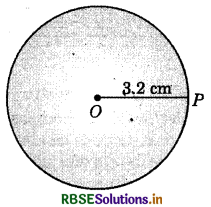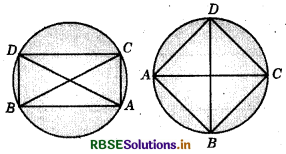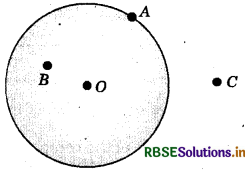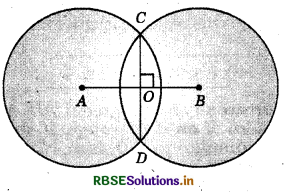RBSE Solutions for Class 6 Maths Chapter 14 Practical Geometry Ex 14.1
Rajasthan Board RBSE Solutions for Class 6 Maths Chapter 14 Practical Geometry Ex 14.1 Textbook Exercise Questions and Answers.
Rajasthan Board RBSE Solutions for Class 6 Maths in Hindi Medium & English Medium are part of RBSE Solutions for Class 6. Students can also read RBSE Class 6 Maths Important Questions for exam preparation. Students can also go through RBSE Class 6 Maths Notes to understand and remember the concepts easily. Students are advised to practice अनुपात और समानुपात के प्रश्न class 6 of the textbook questions.
RBSE Class 6 Maths Solutions Chapter 14 Practical Geometry Ex 14.1
Question 1.
Draw a circle of radius 3.2 cm.
Answer:
Steps of construction :
(a) Mark a point O on the paper.
(b) Open the compass of radius 3.2 cm.
(c) Put the needle of the compass at O and move the pencil slightly the point O.
(d) The figure so obtained is a circle of radius 3.2 cm.

Question 2.
With the same centre O, draw two circles of radii 4 cm and 2.5 cm.
Answer:
Steps of construction :
(a) Mark a point 'O' on the paper to get the centre of the circles.
(b) Open the compasses 4 cm.
(c) Place the pointer of the compasses at O and move it slowly to get the circle.
(d) Again open the compasses 2.5 cm and place the pointer of the compasses on O,
(e) Turn the compasses slowly to draw the second circle.

Hence, it is the required figure.

Question 3.
Draw a circle and any two of its diameters. If you join the ends of these diameters, what is the figure obtained? What figure is obtained if the diameters are perpendicular to each other? How do you check your answer? ,
Answer:
(i) Let AC and BD are diameters of the circle. By joining the ends of these diameters, we get a quadrilateral ABCD. By measuring, we rind AB = CD and BC = AD i.e., pairs of opposite sides are equal also ∠A = ∠B = ∠C = ∠D = 90°.
Hence, it is a rectangle.
(ii) If the diameters are perpendicular to each other, then by joining the ends of two diameters, we get a quadrilateral.
By measuring, we find that AB = BC = CD = DA, i.e. all four sides are equal.
Also ∠A = ∠B = ∠C = ∠D = 90°, i.e. each angle is of 90°. Hence, it is a square.

Question 4.
Draw any circle and mark points A, B and C such that:
(a) A is on the circle.
(b) B is in the interior of the circle.
(c) C is in the exterior of the circle.
Answer:
In the following figure, we have:
A is on the circle.
B is in the interior of the circle.
C is in the exterior of the circle.


Question 5.
Let A and B be the centres of two circles of equal radii; draw them so that each one of them passes through the centre of the other. Let them intersect at C and D. Examine whether \(\overline{A B}\) and \(\overline{C D}\) are at right angles.
Answer:

By measuring the angle ∠AOB, we get that ∠AOB = 90°
Hence \(\overline{A B}\) and \(\overline{C D}\) intersect at right angles.

- RBSE Solutions for Class 6 Maths Chapter 2 Whole Numbers InText Questions
- RBSE Class 6 Maths Important Questions Chapter 1 अपनी संख्याओं की जानकारी
- RBSE Solutions for Class 6 Maths Chapter 7 भिन्न Intext Questions
- RBSE Solutions for Class 6 Maths Chapter 7 Fractions Ex 7.4
- RBSE Solutions for Class 6 Maths Chapter 1 Knowing our Numbers Ex 1.1
- RBSE Solutions for Class 6 Maths Chapter 1 Knowing our Numbers InText Questions
- RBSE Solutions for Class 6 Maths in Hindi Medium & English Medium
- RBSE Solutions for Class 6 Maths Chapter 7 Fractions InText Questions
- RBSE Solutions for Class 6 Maths Chapter 7 Fractions Ex 7.6
- RBSE Solutions for Class 6 Maths Chapter 7 Fractions Ex 7.5
- RBSE Solutions for Class 6 Maths Chapter 7 Fractions Ex 7.3